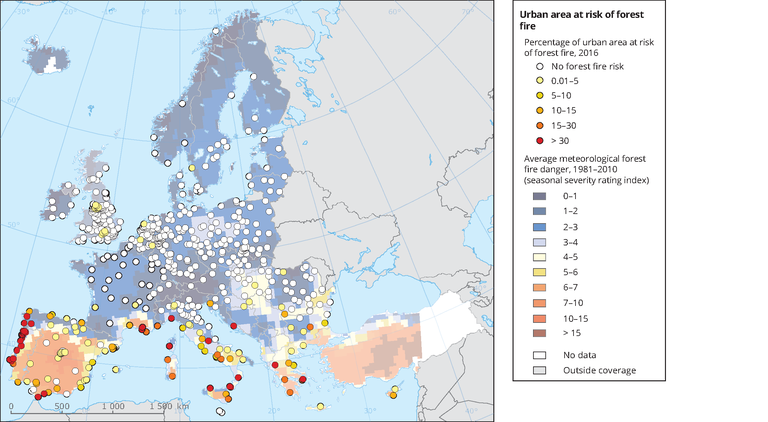All official European Union website addresses are in the europa.eu domain.
See all EU institutions and bodiesUrban areas at risk of forest fire
Map (static)
The map provides an overview of the extent of urban areas at higher risk of being directly affected by forest fires (burning down) under current conditions.

- Austria
- Belgium
- Bulgaria
- Croatia
- Cyprus
- Czechia
- Denmark
- Estonia
- Finland
- France
- Germany
- Greece
- Hungary
- Ireland
- Italy
- Latvia
- Lithuania
- Luxembourg
- Malta
- Netherlands
- Norway
- Poland
- Portugal
- Romania
- Slovakia
- Slovenia
- Spain
- Sweden
- Switzerland
- United Kingdom
Methodology
The indicator provides an overview of the extent of urban and peri-urban areas potentially directly affected by forest fires, by combining the following variables.
1. Select the city’s urban area as reference units.
2. Delineate peri-urban areas around the city’s urban area s:
- a buffer of 20 km outside the border of the city’s urban area ;
- a buffer inward of the city’s urban area , proportional to the degree of soil sealing (up to 50 % confirmed by sensitivity analysis). Inward of the city’s urban area, we do not consider any distance, just the degree of soil sealing. It is generally accepted that vulnerability to fires is higher in low-density settlements, due to a higher proportion of flammable vegetation in the area.
3. Cross the areas selected in 2 with the Burnt areas perimeter from JRC data (2000–2012), resulting in a classification of peri-urban areas and low dense areas inwards the city’s urban area , according to the Burnt areas perimeter from JRC data (2000–2012). The result is shown in one value (%) per city. climate-adapt.eea.europa.eu/repository/11261590.pdf/@@download/file/Fact%20sheets%20final%201_7_2016.pdf
Additional information
The steadily growing interface between vegetated land and urban areas resulting from urban growth and sub-urbanisation in recent decades has amplified the risk of forest fires in many residential areas, especially where cities border forest areas. Factors such as urban density, vegetation characteristics, and the isolation of urban areas from other urban areas and services like transport increase the risk.
It is estimated that around three-quarters of fire ignition points in Mediterranean countries are located at the urban fringes, which combine a high aggregation of vegetation and a high density of houses. Forest fires in Greece in 2007 caused thousands of people to lose their homes. Climate change will contribute to a marked increase of fire danger, particularly in south-western Europe, and an enlargement of the fire-prone area, going north.
